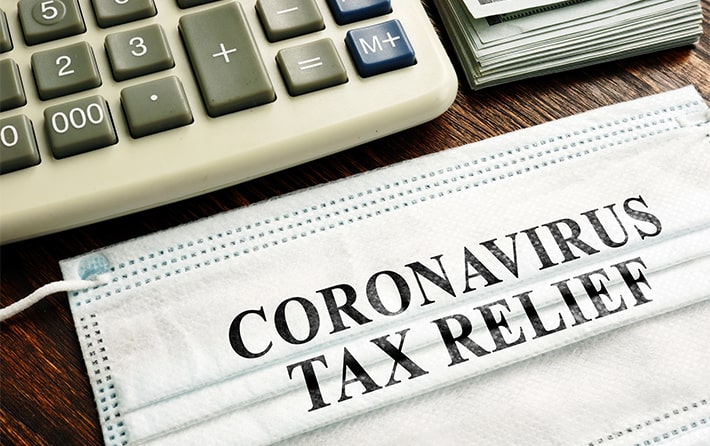12-30-2020 |
Year-End COVID Relief Legislation Becomes Law During the Holidays
By: Christopher Nuss

This past Sunday evening (December 27), President Trump signed into law additional COVID-19 relief legislation, agreed to by Congress a week earlier, estimated at $900 billion as part of the Consolidated Appropriations Act, 2021. Much of the relief comes in the form of tax provisions, known as the COVID-Related Tax Relief Act (the Act), the primary focus of this article.
Paycheck Protection Program (“PPP”) Update.
The Act (1) allocates $284 billion to the second round of PPP and (2) clarifies participants who receive PPP loan forgiveness are not limited in their income tax deductions for eligible business expenses.
- PPP Round 2. The second round of PPP largely mimics the first round, but there are a few changes. Businesses are eligible for the second round of forgivable loans if the applicant (A) employs 300 employees or less, (B) has or will use the full amount of their first-round PPP funds, and (C) experiences a 25% (or more) reduction in gross receipts in 2020 Q1, Q2, or Q3 as compared to the same quarter in 2019. The Act adds additional “eligible expenses” qualifying for loan forgiveness, although loan forgiveness still requires 60% of the PPP loan to be used on payroll costs. As with the first round of PPP, the maximum loan is capped at 250% of the applicant’s average monthly payroll in the previous 12 months or calendar year.
- Deductibility of Eligible Expenses. The Act clarifies that businesses who receive PPP loan forgiveness (round 1 or round 2) are allowed to deduct all eligible business expenses on their income tax return, including the expenses qualifying the business for PPP forgiveness. This overrides previous IRS guidance that prohibited a business from deducting the expenses qualifying the business for PPP loan forgiveness. Thus, businesses who received PPP loan forgiveness (A) should not include the forgiven PPP amounts as taxable income and (B) may deduct all eligible business expenses on their 2020 income tax return, consistent with the intention of Congress. Moreover, any loan forgiveness is not to reduce any tax attribute nor deny any basis increase.
Additional CFAP Money.
The Act allocates over $11 billion to the USDA to use for the Coronavirus Food Assistance Program (“CFAP”) and other similar programs. The Act instructs the USDA to make payments to farmers and producers, implying direct payments from the USDA. Presumably, additional details will follow; however, here are some of the basics.
- Producers of price trigger commodities (including corn and soybeans) and fixed-rate commodities are eligible for additional payments of $20 per acre. These payments should result in an estimated $4.8 billion stimulus to crop farmers.
- $1 billion is allocated to assist contract growers of poultry and livestock to cover up to 80% of the losses they faced in 2020 due to disruptions caused by COVID-19.
- Producers who had losses from “the depopulation of livestock and poultry due to insufficient processing access” are eligible to receive payments up to 80% of the fair market value of the euthanized animals and for the costs of depopulation. Related to income tax, note that changes were made to farmers’ ability to carry back net operating losses.
- Cattle producers can expect additional payments for eligible cattle enrolled in the CFAP and CFAP 2 programs.
Business and Individual Taxes.
The Act contains various provisions that impact income tax reporting in 2020 and beyond.
- As mentioned above, the Act clarifies that businesses that receive PPP forgiveness are not limited in their eligible business deductions in 2020 and 2021.
- Food or beverages provided by a restaurant are eligible for a 100% business expense deduction (rather than the current 50% deduction) for expenses incurred in 2021 and 2022.
- A “recovery rebate” for individuals in the form of a refundable credit for $600 per eligible family member, with phase-out beginning at $75,000 of modified adjusted gross income, to be taken on the 2020 income tax return.
- The Act makes the reduced requirement of 7.5% of adjusted gross income for a medical expense deduction permanent. This reduced requirement, originally 10%, was set to expire in 2020.
- Non-itemized charitable deductions under the CARES Act (the Coronavirus Aid, Relief, and Economic Security Act passed earlier this year) are extended through 2021, and modifications made under the CARES Act to the limitations for certain charitable contributions based on the donor’s percentage of income are also extended through 2021.
- The credit for providing paid sick and family leave under the Family and Medical Leave Act (FMLA) was extended through 2025. This credit was originally set to expire in 2020. Other tax credits extended through 2025 include the new markets and work opportunity programs.
- Taxpayers may refer to earned income from the immediately preceding tax year for purposes of determining the earned income tax credit and the additional child tax credit for the tax year 2020.
- Taxpayers may roll over unused amounts in their health and dependent care flexible spending arrangements from 2020 to 2021 and from 2021 to 2022. The Act also allows taxpayers to make a mid-year prospective change to their contribution amounts in 2021.
- The Act also provides five-year extensions for the exclusion from gross income of a discharge from indebtedness on a principal residence and the exclusion of certain employer payments of student loans.
Payroll Tax Deferral Repayment Extension.
In August 2020, President Trump directed the IRS and the Secretary of Treasury to allow for the deferral of the requirement to withhold, report, and pay certain payroll tax obligations. The IRS issued Notice 2020-65, which allowed businesses to defer those requirements from September of 2020 through December 31, 2020. The deferred amounts would then have to be paid in the first quarter of 2021. The Act provides an extension of this repayment obligation. The Act allows repayment of this deferred amount to occur from January 1, 2021, through December 31, 2021, with penalties beginning to accrue on January 1, 2022.
Employee Retention Credit Modifications.
The Act extends and expands the employee retention credit (ERC), which was originally part of the CARES Act. The extension period is from January 1, 2021, through June 30, 2021. During the extension period, the Act provides the following changes to the ERC:
- The credit rate is increased to 70% from the previous 50% of qualified wages.
- Eligibility for the ERC is expanded by reducing the year-over-year gross receipts decline to 20% from the previous 50%. Certain employers may also use a safe harbor that would allow for the use of prior quarter gross receipts to determine eligibility.
- The limit on per-employee creditable wages would be raised to $10,000 for each quarter from $10,000 for the entire year.
- The definition of “large employer” for the purposes of the ERC would increase to 500 employees from 100 employees.
The full text of the Act can be found here, and a summary by the House Ways and Means Committee can be found here.
Meet the Authors:

